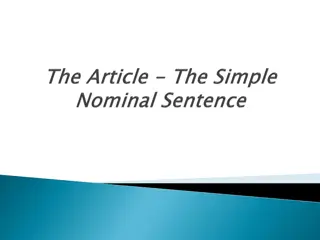Understanding Sentence Types and Verbs in Arabic
Explore the two types of sentences in Arabic - nominal and verbal. Arabic verbs are typically derived from three-letter roots, conveying similar meanings. Discover the unique characteristics of Arabic tenses, emphasizing past, imperfect, and imperative forms.
Download Presentation

Please find below an Image/Link to download the presentation.
The content on the website is provided AS IS for your information and personal use only. It may not be sold, licensed, or shared on other websites without obtaining consent from the author. Download presentation by click this link. If you encounter any issues during the download, it is possible that the publisher has removed the file from their server.
E N D
Presentation Transcript
Sentence Types in Arabic
In Arabic, there are two types of sentences: 1. The nominal sentence ( ): It begins with a noun. For example:
2. The verbal sentence ( ): It begins with a verb. In a verbal Arabic sentence, the normal order is: Verb- subject- object- other items (e.g. adverbials) ... ) For example: ( - - -
Arabic verbs Arabic verbs are mostly derived from roots that are composed of three letters. Most roots in Arabic are composed of three letters, for example, However, there are roots that are composed of more than three letters, such as, The root of a word carries its basic meaning, and all words derived from the same root express similar or related meanings.
All words derived from the same root are found under the dictionary entry of the root For example: The first and the third letters in a root carry the short vowel symbol of fatha, but the second letter may either carry a fatha, a damma, or a kasra. For example: :
Tenses in Arabic Tenses in the Arabic language are not as specific as they are in English. They do not carry accurate time significance. In Arabic, there are only 3 tenses, while in English there are 12 different tenses. The tenses in Arabic are: 1. the perfect or the past tense because it is used to refer to actions or events completed at the time of reference. For example:
2. the imperfect because it is used to refer to actions or events are not completed at the time of reference, whether they are in progress or will happen in the future. For example,
3. the imperative refers to a request or command, so its meaning refers mainly to the future.
Subject-verb agreement in Arabic
When the verb is in the 3rdperson () and it comes before its subject, the verb is always in the singular form The teacher wrote .. The two teachers wrote . The teachers wrote .. First: Verbs preceding subject
When the verb precedes its subject, it will agree with it in gender. The boy grew up The girl grew up The boys grew up The girls grew up The two boys grew up The two girls grew up
With broken plurals, feminine verbs are used unless the broken plural refers to male human beings. For example: The actual gender is always taken into consideration even if the form of a noun does not agree. For example: Not
When the verb follows its subject, it agrees with it in number and gender. For example The boys opened the door The girls entered Second: Verbs following subject
The 3rdperson plural verb is used in the following three cases: 1. when the plural subject is not mentioned. For example: 2. if the subject is placed first for stress or emphasis. For example: 3. if the subject has already been mentioned in a previous sentence. For example: . Using the 3rdperson plural verb
Translate the following: The student came. The two students came. The girl came. The boys came. The women came. The men went to the mosque. The students took their exam. Then, they went home. Revision























